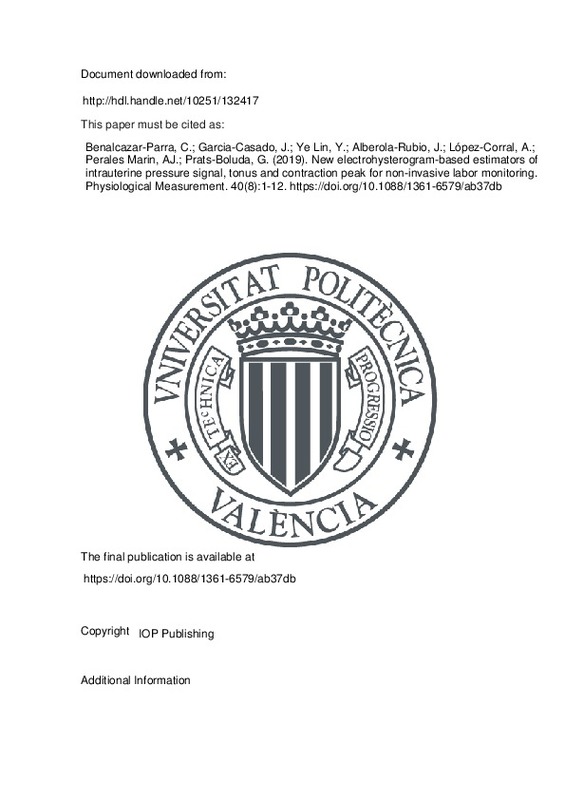JavaScript is disabled for your browser. Some features of this site may not work without it.
Buscar en RiuNet
Listar
Mi cuenta
Estadísticas
Ayuda RiuNet
Admin. UPV
New electrohysterogram-based estimators of intrauterine pressure signal, tonus and contraction peak for non-invasive labor monitoring
Mostrar el registro sencillo del ítem
Ficheros en el ítem
| dc.contributor.author | Benalcazar-Parra, Carlos
|
es_ES |
| dc.contributor.author | Garcia-Casado, Javier
|
es_ES |
| dc.contributor.author | Ye Lin, Yiyao
|
es_ES |
| dc.contributor.author | Alberola-Rubio, José
|
es_ES |
| dc.contributor.author | López-Corral, Angel
|
es_ES |
| dc.contributor.author | PERALES MARIN, ALFREDO JOSE
|
es_ES |
| dc.contributor.author | Prats-Boluda, Gema
|
es_ES |
| dc.date.accessioned | 2019-12-04T21:00:59Z | |
| dc.date.available | 2019-12-04T21:00:59Z | |
| dc.date.issued | 2019 | es_ES |
| dc.identifier.issn | 0967-3334 | es_ES |
| dc.identifier.uri | http://hdl.handle.net/10251/132417 | |
| dc.description.abstract | [EN] Background: Uterine activity monitoring is an essential part of managing the progress of pregnancy and labor. Although intrauterine pressure (IUP) is the only reliable method of estimating uterine mechanical activity, it is highly invasive. Since there is a direct relationship between the electrical and mechanical activity of uterine cells, surface electrohysterography (EHG) has become a noninvasive monitoring alternative. The Teager energy (TE) operator of the EHG signal has been used for IUP continuous pressure estimation, although its accuracy could be improved. We aimed to develop new optimized IUP estimation models for clinical application. Approach: We first considered enhancing the optimal estimation of IUP clinical features (maximum pressure and tonus) rather than optimizing the signal only (continuous pressure). An adaptive algorithm was also developed to deal with inter-patient variability. For each optimizing signal feature (continuous pressure, maximum pressure and tonus), individual (single patient), global (full database) and adaptive models were built to estimate the recorded IUP signal. The results were evaluated by computing the root mean square errors (RMSe): continuous pressure error (CPe), maximum pressure error (MPe) and tonus error (TOe). Main results: The continuous pressure global model yielded IUP estimates with Cpe = 14.61mm Hg, MPe = 29.17mm Hg and Toe = 7.8mm Hg. The adaptive models significantly reduced errors to CPe = 11.88, MPe = 16.02 and Toe = 5.61mm Hg. The EHG-based IUP estimates outperformed those from traditional tocographic recordings, which had significantly higher errors (CPe = 21.93, MPe = 26.97, and TOe = 13.96). Significance: Our results show that adaptive models yield better IUP estimates than the traditional approaches and provide the best balance of the different errors computed for a better assessment of the labor progress and maternal and fetal wellbeing. | es_ES |
| dc.description.sponsorship | This research project was supported by the Spanish Ministry of Economy and Competitiveness, the European Regional Development Fund (DPI2015-68397-R), and by the projects UPV_ FE-2018-C03 and GV/2018/104. | es_ES |
| dc.language | Inglés | es_ES |
| dc.publisher | IOP Publishing | es_ES |
| dc.relation.ispartof | Physiological Measurement | es_ES |
| dc.rights | Reserva de todos los derechos | es_ES |
| dc.subject | Intrauterine pressure | es_ES |
| dc.subject | Uterine activity | es_ES |
| dc.subject | Surface electromyography | es_ES |
| dc.subject | Electrohysterography | es_ES |
| dc.subject | Teager energy | es_ES |
| dc.subject.classification | TECNOLOGIA ELECTRONICA | es_ES |
| dc.title | New electrohysterogram-based estimators of intrauterine pressure signal, tonus and contraction peak for non-invasive labor monitoring | es_ES |
| dc.type | Artículo | es_ES |
| dc.identifier.doi | 10.1088/1361-6579/ab37db | es_ES |
| dc.relation.projectID | info:eu-repo/grantAgreement/MINECO//DPI2015-68397-R/ES/ELECTROHISTEROGRAFIA, CONSTRUYENDO PUENTES PARA SU USO CLINICO EN OBSTETRICIA/ | es_ES |
| dc.relation.projectID | info:eu-repo/grantAgreement/UPV//UPV-FE-2018-C03/ES/ÚTERO NO GESTANTE: ESTUDIO DE PERISTASIS CON ELECTROHISTEROGRAFÍA/ | es_ES |
| dc.relation.projectID | info:eu-repo/grantAgreement/GVA//GV%2F2018%2F104/ | es_ES |
| dc.rights.accessRights | Abierto | es_ES |
| dc.contributor.affiliation | Universitat Politècnica de València. Departamento de Ingeniería Electrónica - Departament d'Enginyeria Electrònica | es_ES |
| dc.contributor.affiliation | Universitat Politècnica de València. Servicio de Alumnado - Servei d'Alumnat | es_ES |
| dc.contributor.affiliation | Universitat Politècnica de València. Instituto Interuniversitario de Investigación en Bioingeniería y Tecnología Orientada al Ser Humano - Institut Interuniversitari d'Investigació en Bioenginyeria i Tecnologia Orientada a l'Ésser Humà | es_ES |
| dc.description.bibliographicCitation | Benalcazar-Parra, C.; Garcia-Casado, J.; Ye Lin, Y.; Alberola-Rubio, J.; López-Corral, A.; Perales Marin, AJ.; Prats-Boluda, G. (2019). New electrohysterogram-based estimators of intrauterine pressure signal, tonus and contraction peak for non-invasive labor monitoring. Physiological Measurement. 40(8):1-12. https://doi.org/10.1088/1361-6579/ab37db | es_ES |
| dc.description.accrualMethod | S | es_ES |
| dc.relation.publisherversion | https://doi.org/10.1088/1361-6579/ab37db | es_ES |
| dc.description.upvformatpinicio | 1 | es_ES |
| dc.description.upvformatpfin | 12 | es_ES |
| dc.type.version | info:eu-repo/semantics/publishedVersion | es_ES |
| dc.description.volume | 40 | es_ES |
| dc.description.issue | 8 | es_ES |
| dc.relation.pasarela | S\396939 | es_ES |
| dc.contributor.funder | Generalitat Valenciana | es_ES |
| dc.contributor.funder | Universitat Politècnica de València | es_ES |
| dc.contributor.funder | Instituto de Investigación Sanitaria La Fe | es_ES |
| dc.contributor.funder | Ministerio de Economía y Competitividad | es_ES |







![[Cerrado]](/themes/UPV/images/candado.png)

